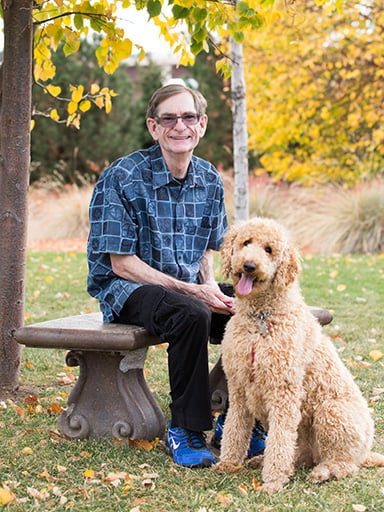 Louis and his poodle, Doodles, on one of their four walks every day
Louis and his poodle, Doodles, on one of their four walks every day
A year ago, HIV patient Louis Zimmerman considered himself sedentary. But thanks to his participation in a CU Anschutz exercise study, he now is able to walk his one-year-old poodle, Doodles, four times a day.
“I’m walking faster with more pep in my step,” says Zimmerman, 66, one of about 50 participants in a study of HIV-infected patients, run by Kristine Erlandson, MD, assistant professor of infectious diseases in the CU School of Medicine, with an adjunct appointment in geriatric medicine.
 Kristine Erlandson, MD
Kristine Erlandson, MD
Erlandson, who is board certified in internal medicine and infectious disease, specializes in treating frail and older HIV-infected patients. Affiliated with CU Anschutz since 2008, Erlandson also conducts research studies on patients who have lived decades with HIV.
Erlandson says she became interested in learning about AIDS in high school and was an HIV educator in college. She particularly remembers Ryan White, an Indiana teen who got HIV from a blood transfusion and helped start the movement to stop AIDS discrimination.
“He was a similar age as I was and it stood out for me,” she says.
As for her interest in HIV and aging, she added: “As a fellow during my infectious diseases training, I was most surprised by the HIV patients who would come into the hospital – they had diseases that should be impacting much older people.”
Erlandson sees commonalities in the challenges of her older HIV patients and hopes her studies will improve lives.
“Most of the people I focus my research on are those diagnosed with HIV back in the late ‘80s or early ‘90s who are now experiencing the long-term side effects of drug therapies that go back 20 or 30 years,” she says.
Zimmerman is a participant in one of Erlandson’s studies that measures how exercise can improve the health of sedentary people ages 50-75. One group is HIV-infected and the other study subjects don’t have HIV. Both groups are in stable health and work out as part of the study for six months at the university’s research gym.
During the study, Zimmerman walked on the treadmill and worked with weights three days a week. At the end of six months, he says he felt stronger and had more energy. His outcomes are similar to other participants’ experiences, Erlandson says.
“Almost everyone has marked improvements in their strength and endurance,” she says. “And we’ve seen good improvements in basic physical function measures, such as the ability to walk a quarter mile and the speed to rise from a chair.”
A patient’s experience
 Louis and Doodles
Louis and Doodles
Doctors diagnosed Zimmerman with HIV and Hepatitis C in 1996 at age 47.
A delivery person for Dolly Madison Bakeries, Zimmerman said he tried to go to work one day and collapsed.
“I couldn’t stand up any longer,” he says. He learned he had pneumocystis pneumonia, an infection fairly common in people with compromised immune systems.
At first, Zimmerman, who had many friends and acquaintances die of AIDS, thought it was a death sentence. But then he started doing research on HIV.
“I didn’t have any information prior to the diagnosis,” he says. “But I started doing research and I’ve kept it up ever since. That’s my job now.”
Zimmerman also has been active in HIV research studies. He’s participated in nine clinical trials since his diagnosis. A tough treatment regimen cured his Hepatitis C, but the early HIV treatments were harder on the body than today’s drug regimens. As a result, he’s suffered neuropathy and had fat loss (lipatrophy) in his face. He also was diagnosed with a rare form of skin cancer that has required 25 radiation treatments.
The work ahead
In addition to her exercise study, Erlandson has also studied the factors that contribute to frailty in HIV patients and how to prevent them. She’s recently started a study in conjunction with the AIDS Clinical Trials Group to look at the effect of statins on physical function in HIV patients.
Erlandson’s hope is that her work will not only help her HIV patients, but that her trainees will have a greater understanding of how to manage HIV and help prevent HIV-associated complications in aging.
“There’s still a lot of research to be done by the next generation of physician scientists,” she says.
Living a positive life
In the nearly 20 years since Zimmerman was diagnosed with HIV, he says he’s stronger than he realized and he doesn’t give up.
“If I start thinking about anything negative, I get it out of my brain right away,” he says. “Dying is the last thing I think about.”
His advice to fellow HIV patients is to stay positive and build a social network of supportive friends and family.
Zimmerman’s year-old poodle, Doodles, is his constant companion. He laughs as he talks about how she walks on her hind legs like a bear. He says he wants to stay healthy for her.
Says Zimmerman, “A dog lives 15 years, so I have 14 more years to be alive for my puppy.”
Guest Contributor: Kathleen Bohland
